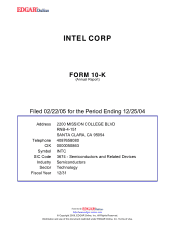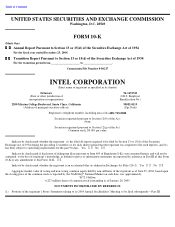Intel 2004 Annual Report Download - page 8
Download and view the complete annual report
Please find page 8 of the 2004 Intel annual report below. You can navigate through the pages in the report by either clicking on the pages listed below, or by using the keyword search tool below to find specific information within the annual report.
Table of Contents
In May and June 2004, we introduced new Intel Pentium M processors built on our 90-nanometer, 300-millimeter (mm) process
technology. These Intel Pentium M processors 715, 725, 735, 745 and 755 feature speeds from 1.5 GHz to 2.0 GHz, include 2 MB of L2 cache
and support a 400-MHz bus. In October 2004, we added the Intel Pentium M processor 765 running at 2.1 GHz, which also features 2 MB of
L2 cache and supports a 400-MHz bus.
In July 2004, we launched the Intel
®
Pentium
®
M processor Low Voltage 738 running at 1.4 GHz, the Intel
®
Pentium
®
M processor
Ultra Low Voltage 733 running at 1.1 GHz and the Intel
®
Pentium
®
M processor Ultra Low Voltage 723 running at 1.0 GHz. These three
processors also feature 2 MB of L2 cache and support a 400-MHz bus. In addition, we offer the Intel
®
Pentium
®
M processor Low Voltage
running at 1.3 GHz and the Intel
®
Pentium
®
M processor Ultra Low Voltage running at 1.1 GHz. These two processors support a 400-MHz
bus and include 1 MB of L2 cache.
In June 2004, we introduced the Mobile Intel Pentium 4 processors 518, 532 and 538 with speeds of up to 3.2 GHz, designed for portable
PC users who want systems with near-desktop features. In September 2004, we launched the Mobile Intel Pentium 4 processor 548, with a
speed of 3.33 GHz. All of these processors are built using 90-nanometer process technology, support HT Technology, include 1 MB of L2
cache and support a 533-MHz bus.
In addition, for the mobile value market segment, we offer the Intel
®
Celeron
®
M processor and the Mobile Intel Celeron processor. In
2004, we introduced several versions of the Intel Celeron M processor for mobile PCs with speeds of up to 1.5 GHz. Two of these, the Intel
Celeron M processors 350 and 360, are built using our 90-nanometer process technology. We also introduced Intel
®
Celeron
®
M processors
Ultra Low Voltage at speeds of up to 900 MHz. All of these versions of the Intel Celeron M processor support a 400-
MHz bus, have 512 KB of
L2 cache and offer power management features designed to lengthen battery life.
Enterprise Market Segment
We develop platform solutions based on our microprocessors, chipsets and motherboard products that are optimized for use in the
enterprise market segment. Our strategy is to provide processors and chipsets with improved performance, which includes advanced technology
features, as well as competitive price for performance for entry-level to high-end servers and workstations. Servers are systems, often with
multiple microprocessors working together, that manage large amounts of data, direct traffic, perform complex transactions and control central
functions in local and wide area networks and on the Internet. Workstations typically offer higher performance than standard desktop PCs, and
are used for applications such as engineering design, digital content creation and high-performance computing, among other applications. Our
Intel Xeon processor family of products supports a wide range of entry-level to high-end technical and commercial computing applications for
both the workstation and server market segments.
The Intel Xeon processor is designed for two-way servers, also known as dual-processing (DP) servers, and workstations. This product
line, based on our IA-32 architecture, was enhanced in 2004 with Intel
®
Extended Memory 64 Technology. This technology enables support of
both 32-bit and 64-bit operating systems and applications. These processors are available for both workstations and DP servers. For servers
based on four or more processors, also known as multiprocessing (MP) servers, we offer the Intel
®
Xeon
™
processor MP with HT Technology.
Our Intel
®
Itanium
®
processor family, which is based on 64-bit architecture and includes the Intel
®
Itanium
®
2 processor, generally supports
an even higher level of computing performance for data processing, the handling of high transaction volumes and other compute-intensive
applications for enterprise-class servers, as well as supercomputing solutions.
In March 2004, we introduced the Intel Xeon processor MP at 3.0 GHz. It features 4 MB of L3 cache and is designed for mid-tier and
back-end servers based on four or more processors. We also introduced the Intel Xeon processor MP running at 2.2 GHz and 2.7 GHz with 2
MB of L3 cache.
In June 2004, we introduced several new Intel Xeon processors that incorporate Intel Extended Memory 64 Technology and are
manufactured on our 90-nanometer, 300mm process technology. These processors are available for both workstations and DP servers, and
feature enhanced HT Technology to improve the performance of multithreaded applications. These processors also support Demand-Based
Switching technology to reduce overall power consumption within data centers. These processors are available in speeds ranging from 2.8 GHz
to 3.6 GHz.
Also in 2004, we introduced the Intel
®
E7525 chipset for Intel Xeon processor-based workstation platforms. The new chipset has an 800-
MHz bus, supports DDR2 memory technology, and integrates several new technologies, including PCI Express, that help eliminate system
bottlenecks by balancing performance between the processor, input/output and memory. Workstation platforms based on Intel Xeon processors
and the new Intel E7525 chipset feature higher performance and lower power consumption than previous generations of Intel Xeon processor-
based workstation platforms.
5





















